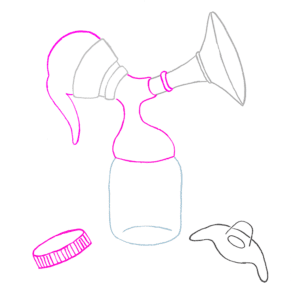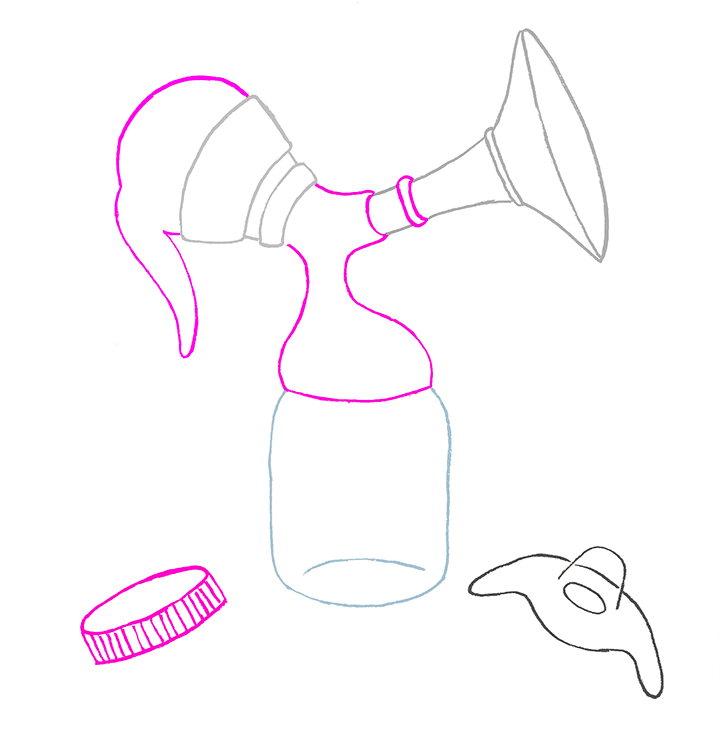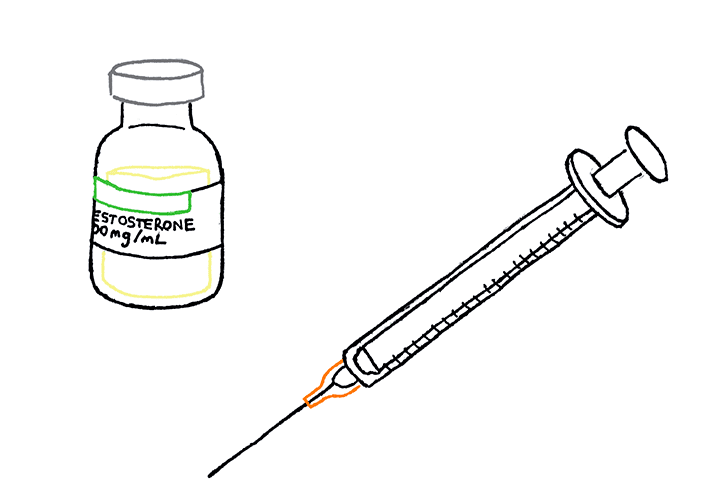
I was early to the breastfeeding group and decided to sit on a couch and nurse Samson before anyone else arrived. When my son slipped off my nipple into a nap in my arms, I realized I needed to pee. Badly. In the yoga studio’s restroom I struggled to hold him, unzip my pants, lower my three-weeks-postpartum self to the toilet—how does anyone do all this? After, I stood in front of the mirror. My breasts disturbed me. They expanded between feedings, leaked constantly, and insisted on reminding me of their presence.
Samson wasn’t my first baby; my partner, Anna, had given birth to our son, Sean, a year earlier. But being pregnant myself, giving birth, and trying to breastfeed presented me with a new, terrifying experience: another human being relied on me, on my organs, my blood supply, and in deciding to breastfeed, I’d signed up for this continued intimate, animalistic connection between us.
Anna seemed deeply connected to her female body. I identified as nonbinary and had at best a tenuous level of acceptance towards mine, my breasts especially. Breastfeeding presented me with the imperative to think about and use them dozens of times a day, and in the early postpartum period I came close to quitting daily.
Even with a supportive, knowledgeable partner at home, I felt alone.
Go to the group, Anna said, It’ll help. But in my mind there was nothing that could help, especially not a group of women. Who could understand how my desire to provide my child with breastmilk had coupled with intense shame and revulsion at my body, more womanlike than it had ever been? Go, she said. Try it.
All my life—in my girls’ Catholic high school, in the faculty rooms of the schools where I worked almost exclusively alongside women, in every mall and public restroom and checkout line and doctor’s office—people struggled with categorizing me. Others’ confusion fueled my own confusion. I was and had always been more masculine than the women I knew. Yet unlike some of the other trans people I’d met, I had taken no steps towards trying to figure out what would make me more comfortable. Here I was, having done something the world saw as irredeemably feminine. Pregnancy. Childbirth.
I sat in a circle with the other women in the breastfeeding group and we were encouraged to share a brief introduction and status update: who we were, how our births had been, how breastfeeding was going. In Samson’s first few weeks, I had seen a lactation consultant because my body made so much milk that I was overwhelming Samson with it, causing him to gag and turn away while eating. But the real problem with breastfeeding was that it was overwhelming me. Being forced to think about my breasts so much throughout the day. Feeling them fill with milk between nursing sessions, waking to the pain of overfilled milk ducts, worrying about milk leaking through my breast pads and bras, needing to return home after an hour or two out of the house to nurse again. All of this focus on my breasts and their sensations made me feel disconnected from other parts of my body and, by extension, who I actually was.
When it was my turn to speak, I steeled myself for the typical up and down looks as strangers tried to understand my gender—what are you? A dozen women stared at me, infants in their arms or on their laps or on blankets set on the hardwood floor. They were waiting for me to speak. I was afraid to explain what it was like to breastfeed with gender dysphoria, to be confronted with an onslaught of emotions about the wrongness of my body. So I focused on the birth, my most macho summary: Samson was born a few hours after a Crossfit workout, squatting in the bathroom of the birthing center when I couldn’t make it fast enough to the bed. As for breastfeeding, I told the group it was going alright, I guess.
Mostly, I listened. Some of the women, like me, left out their most personal struggles, simply giving their name and their baby’s name and maybe another sentence or two. Others rattled off a litany of breastfeeding concerns. They had arrived at the yoga studio armed with breast pumps, nipple shields, little coolers of breastmilk and formula. They had seen specialists, nursed after breast reductions, after illness, despite their babies’ prematurity or anatomical abnormalities. For each of them, breastfeeding was not the simple, automatic biological process many people assume it might be. It required sustained daily effort to stay afloat.
Breastfeeding was, in many ways, an expected part of my parenting journey. I was breastfed, as were my five siblings. Same with Anna and her two brothers. Anna nursed our first child. It was something important to our family, something I felt was part of the deal of gestating a human. I decided to give it a shot. But I knew myself well enough to know that, presented with any significant obstacle, I’d likely abandon it.
I surprised myself and everyone else by deciding to carry a baby; most of our friends and family assumed Anna would handle that responsibility. But she and I wanted our first children to be close together in age, and after watching her go through an easy pregnancy, I thought I could handle a year of bodily turmoil. The moment Samson was born, I was ready to get my body back. Pregnancy had a beginning and end date. Breastfeeding, on the other hand, could last a day or five years. It was up to me to decide how much I could handle.
One of the women who’d been coming to the breastfeeding group for a number of months said that every two weeks, she set the goal for herself to make it to the next group. Every morning since Samson was born I’d woken up with him next to me, crying, rooting for my breasts—my depressing, lumpy, full breasts—and I wondered if I could make it through another day. Maybe I could use this support group to help.
I made it two weeks. And another two weeks. Every time I left, I told myself I’d try to make it to the next one. This is how I had made it through so many years as an often-unhappy queer person, by telling myself: Make it to your birthday, see how you feel then. Maybe when it’s winter and you’re wearing more layers, these feelings will pass. I was practiced in the art of waiting out my own feelings.
Early on in my nursing journey, a woman in the breastfeeding group admitted she struggled with eating disorders and that her changed body, particularly her larger breasts and hips, caused her a lot of stress. After she shared that, I started to talk more, encouraged by the support and responses she received. When small issues came up between me and Samson—I went away for a week and got a plugged duct I couldn’t get rid of and Samson steadfastly refused to accept pumped milk—they supported me, and I tried to turn that around. I learned as much as I could about breastfeeding, donated breastmilk to a woman from the group who’d had surgery, delivered spare breast pump parts to a downtown office building when another forgot to bring hers to work. And, with the help of the women around me, I continued to nurse.
I was accepted in my complex form as someone who was different from the women in the group but who had been through the transformation pregnancy and breastfeeding enacts on any body. I never said the word transgender—I was too afraid then to say it to anyone—but I did tell the group I was struggling with dysphoria about my breasts, that I didn’t identify as a mother or a woman. Sometimes I felt out of place among women, even in group, but there I was, with this ripped-open, leaking body, with so many questions. I had what seemed to be the group’s only true prerequisite: a baby latched onto my nipple.
Outside the group, I felt out of place in parenting. I wasn’t quite a mom or a dad. Staying home with my children was lonely, and other parents seemed to shy away from speaking to me at the playground because of how I looked. Sometimes, mothers in my neighborhood thought I was my children’s babysitter. I figured it was a difficult mental leap to make, seeing someone gender ambiguous, pierced, and tattooed, as a genuine parent.
My breastfeeding goal had been six weeks. I made it two years.
Samson is five. It’s been three years since I last breastfed him. Within a few months of weaning, I was sitting in another support group, this one for transmasculine people. I’d known about the group for years but worried I wasn’t trans enough. That I was confused. That I’d be rejected or end up feeling more hopeless than I’d started out.
For me, transitioning was not a life or death situation. I didn’t even identify as a man or a trans man. To the handful of friends I talked to about gender, I was genderqueer, transmasculine, or not a woman. That was the big one. Not a woman. It’s hard to know what to do when you define yourself entirely by what you’re not. Knowing what to do with that feeling, the feeling that something is wrong but that you don’t know what would be right, was something I could not deal with alone.
Taking the first step was the hardest part, something I delayed for years. When I was depressed, I’d think of myself as an old person, still in the same body I’d waffled about changing, the body I’d hated, stuck in the cycle of fear. So many embarrassed public interactions. Here you go, sir, um, ma’am, um, sorry. I hated that life, wanted more for myself. I began taking testosterone.
Even though I now pass as male, Samson left a lasting impression on my body. My body’s history of pregnancy, of breastfeeding, is something that makes me stand out from every other guy I’ve met. I still have my breasts, but after pregnancy, nursing, and years of hormones and binding, they’re like old down pillows, floppy and listless. I still have a strange hitch in my right hip that I’ve avoided trying to explain to my Crossfit coaches. Your squat is weird, a coach said to me recently, frowning. I have a… funky hip, I said. Most people I interact with in the small town in Michigan where I now live have no idea I birthed someone. It never seems the right time to tell a person who might not even know I am trans: Yeah, man, ever since pregnancy and childbirth, my hips have never been the same.
The breastfeeding group provided practical nursing advice, sure, but more essentially, it made me feel like I belonged despite being an ambiguous person. The women in group adjusted their expectations of what breastfeeding group was to include me, something for which I’m forever indebted to them. My experiences mattered. I deserved support. Like all bodies, mine has a complicated history and an uncertain future, but breastfeeding group taught me how to make space for myself and step in where space was made for me.
***
Rumpus original art by Cowboy Rocky.







